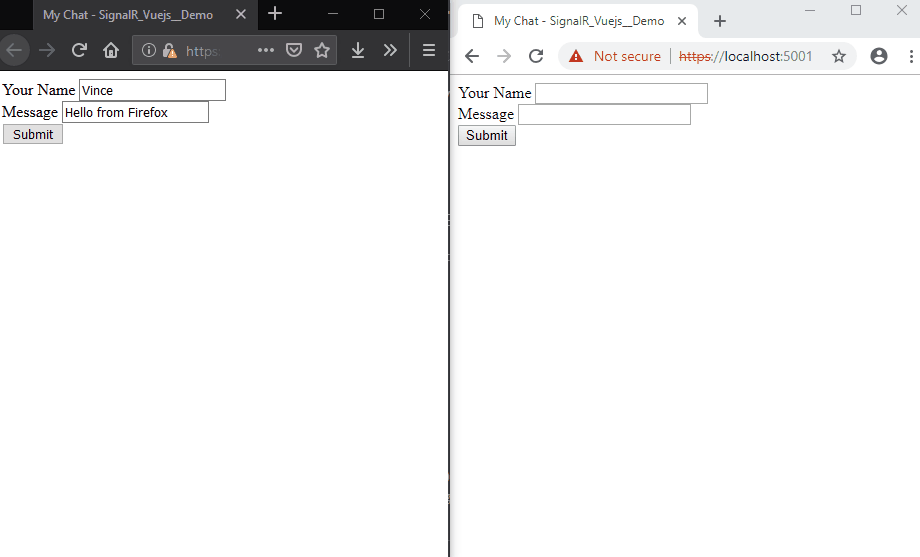Set up SignalR in a vue.js project
Table of contents
SignalR is an ASP.NET library for real-time applications. It uses the WebSockets API:
The WebSocket API is an advanced technology that makes it possible to open a two-way interactive communication session between the user’s browser and a server. With this API, you can send messages to a server and receive event-driven responses without having to poll the server for a reply. The WebSocket API (WebSockets) - MDN
SignalR comes pre instal with ASP.NET Core 2.1. If you don’t have .NET core SDK on your machine, you can instal this one from the microsoft website
I build a small demo using SignalR with Vue.js:

Create a new .NET core MVC project
Create a new .NET core MVC project.
If you are using the terminal run:
dotnet new mvcSet up our hub
First, we need to create a hub. The hub is a class used for persistent connections between the client and the server.
At the root of our project lets create a ChatHub.cs:
using Microsoft.AspNetCore.SignalR;
using System.Threading.Tasks;
namespace signalrChatApp
{
public class ChatHub : Hub
{
public async Task SendMessage(string user, string message)
{
await Clients.All.SendAsync("ReceiveMessage", user, message);
}
}
}
In Startup.cs
//...
using signalrChatApp;
//...
namespace MyApp
{
public class Startup
{
//...
public void ConfigureServices(IServiceCollection services)
{
//...
services.AddSignalR();
}
//...
public void Configure(IApplicationBuilder app, IHostingEnvironment env)
{
//...
app.UseSignalR(routes =>
{
routes.MapHub<ChatHub>("/chatHub");
});
}
}
}
Set up our front end with vue.js
We are going to use the Views/Home/Index.cshtml file to make our demo, I got rid of all the unused markup in this file and the _lautout.cshtml as well
Add our dependencies
First, we need the @aspnet/signalr package. You can download it from npm
npm install @aspnet/signalrCopy the file in node_modules/@sapnet/signalr/dist/browser/signalr.js into the wwwroot folder.
Now we need the reference this file in our view
<script src="~/signalr.js"></script>We are going to add vue.js with a CDN as well:
<!-- (Developer version) -->
<script src="https://cdn.jsdelivr.net/npm/vue/dist/vue.js"></script>Front End
Now that our dependencies have been added, let’s work on the Front End.
Above our script let’s add our app markup:
<div id="chatApp">
<div class="form-group">
<form>
<div>
<label for="userName">Your Name</label>
<input type="text" name="Name" id="userName" v-model="userName" />
</div>
<div>
<label for="userMessage">Message</label>
<input
type="text"
name="Message"
id="userMessage"
v-model="userMessage"
/>
</div>
<button v-on:click="submitCard" type="button">Submit</button>
</form>
<ul v-for="(item, index) in messages" v-bind:key="index + 'itemMessage'">
<li><b>Name: </b>{{item.user}}</li>
<li><b>Message: </b>{{item.message}}</li>
</ul>
</div>
</div>Now lets set up our script:
document.addEventListener("DOMContentLoaded", function(event) {
var app = new Vue({
el: "#chatApp",
data: {
userName: "",
userMessage: "",
connection: "",
messages: []
},
methods: {
submitCard: function() {
if (this.userName && this.userMessage) {
// ---------
// Call hub methods from client
// ---------
this.connection
.invoke("SendMessage", this.userName, this.userMessage)
.catch(function(err) {
return console.error(err.toSting());
});
this.userName = "";
this.userMessage = "";
}
}
},
created: function() {
// ---------
// Connect to our hub
// ---------
this.connection = new signalR.HubConnectionBuilder()
.withUrl("/chatHub")
.configureLogging(signalR.LogLevel.Information)
.build();
this.connection.start().catch(function(err) {
return console.error(err.toSting());
});
},
mounted: function() {
// ---------
// Call client methods from hub
// ---------
var thisVue = this;
thisVue.connection.start();
thisVue.connection.on("ReceiveMessage", function(user, message) {
thisVue.messages.push({ user, message });
});
}
});
});